We support our Publishers and Content Creators. You can view this story on their website by CLICKING HERE.
Guest post by Joe Hoft at JoeHoft.com – republished with permission

Election Reconciliation Guidebook for Election Officials
(The following guidebook provides information on why reconciliations can help ensure free, fair and transparent election results and templates that can be used to assist in this effort. A pdf of the template is included at the end.)
What are election reconciliations?
Reconciliations are simple tools used by corporations. Auditors compare separate sets of records to see if the totals match to determine if financials are accurate and trustworthy.
Election reconciliations compare different types of election records for the following purposes:

Critical success factors for successful election reconciliations
- Chain of custody forms and procedures follow Election Assistance Commission (EAC) guidelines Chain of Custody Best Practices (eac.gov)
- Reconciliations conducted daily under canvassing board oversight
- Incorporation of political parties, candidates, and public observation, reporting, and escalation procedures to make the process self-authenticating
- Completion before election certification with corrective measures if problems are identified
Election Reconciliation Steps
Prior to the election
1) Review the following ballot chain of custody transport forms and procedures and make necessary corrections consistent with EAC guidelines.
- From drop boxes, the Post Office, and election offices to the counting center
- Work Areas within the counting center
- Polling Places to the election center
- Temporary storage to long-term storage
2) Review polling place reporting requirements and make necessary corrections to enable reconciliations.
3) Assign a chain of custody and reconciliation manager with daily reporting and escalation requirements.
4) Create a robust observation and election document availability program for political parties, candidates, and the public to participate in the reconciliation process, making it self-authenticating. Increase trust by enabling independent verification of election reconciliations.
During the election
5) Conduct daily reconciliations of Vote-by-mail, Early Voting, and on Election Day and take corrective actions if discrepancies are identified.
6) Provide for Election Board review of daily reconciliation reports and final reconciliations before certification.
(Sample ballot chain of custody and polling place reporting forms, reconciliation forms, and suggested observation and reports are available in the exhibit section of this document.)
Overview of the Reconciliation Process
Putting it all together, the process looks like this:
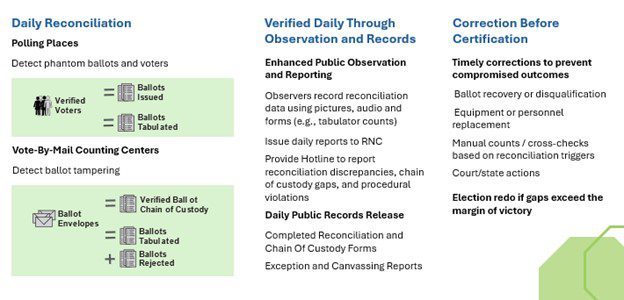
The election board should not certify an election unless:

Election Day Reconciliations – the following election records should reconcile:

- If polling location ballot reports do not reconcile, Election Day ballots from that location should be hand-counted before certification.
- The vote counts by race per the poll tapes should be calculated and compared to election day result reports. If the Election Day poll tape totals for a race do not reconcile, that race should be hand-counted before certification.
- Additionally, the following reconciliations should be performed:
- # of Ballots issued to polling place = # of tabulated ballots + #unused ballots + provisional ballots + spoiled ballots
- Protected total count of ballots at close of Election Day = Protected total count of ballots at opening of Election Day + total ballots counted on Election Day
- Political parties, candidates, and the public can validate Election Day reconciliations using pictures or data recorded by observers and published election documents (e.g. chain of custody forms and completed reconciliation forms). An example of what can be done is:
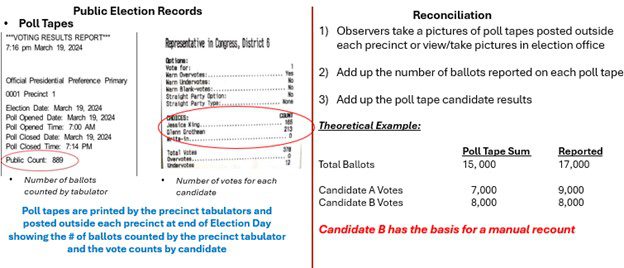
Early Voting Reconciliations
Early voting reconciliations are similar to Election Day reconciliations except no poll tapes are available to political parties, candidates, or the public.
Vote-by-Mail Reconciliations
Reconciliations of vote-by-mail ballots must be completed to verify that all legal ballots and only legal ballots are counted:

Before absentee ballots are counted, political parties and candidates should examine ballot Chain of Custody forms in the manner that signatures are inspected. Chain of Custody forms that do not provide evidence of chain of custody or a lack ballot quantities can be challenged.
The vote-by-mail ballot reconciliation calculation is:

Here is an example:

If there is a vote-by-mail reconciliation gap, any race whose margin of victory exceeds the gap should not be certified and must be re-done. Thus, it is critical reconciliations are completed before certification. Ideally, reconciliations are performed daily so that problems can be addressed before election outcomes are compromised.
Additionally, the following reconciliations should be performed:
- # of vote-by-mail ballots mailed out = Post Office billing records
- # of vote-by-mail ballots returned by voters <= the number of ballots requested by voters
- # of voted ballots received from the Post Office = Post Office billing record quantity if return postage is paid for by the election office
- # of voted ballots received from the Post Office = number of envelopes with postage stamps if return postage is not paid for by the election office
- # of faxed ballots duplicated = # received per the facsimile log
- # of voted and tabulated ballots transferred to storage = # ballots reported as counted
- # of envelopes transferred to storage = # of ballots recorded on chain of custody forms
- # of ballots processed through inbound mail sorter = # ballots counted +# ballots ineligible
- Each counting center public tabulator count total at close of each day = public tabulator count totals at opening of the next day
Additional References
The following documents may also be of use to election officials:
Position paper on election reconciliation controls: Reconciliation Controls to Prevent Illegal Vote-By-Mail Ballot Insertion and Legal Ballot Deletion
Model election security plan: Model Elections Security Plan v27
Exhibits
Exhibit 1 Drop box Chain of Custody Form
Exhibit 2 Post Office Chain of Custody Form
Exhibit 3 Facsimile Log
Exhibit 4 Work Area Chain of Custody Form
Exhibit 5 Vote-by-mail reconciliation
Exhibit 6 Early Voting reconciliation
Exhibit 7 Election Day reconciliation
Exhibit 8 Public Observation recommendations
Exhibit 9 Public Records recommendations
Note: These are templates that need to be adapted by local election officials based on state law, technology adoption, and policies
Exhibit 1: Dropbox Chain of Custody Form

Exhibit 2: Post Office Chain of Custody Forms
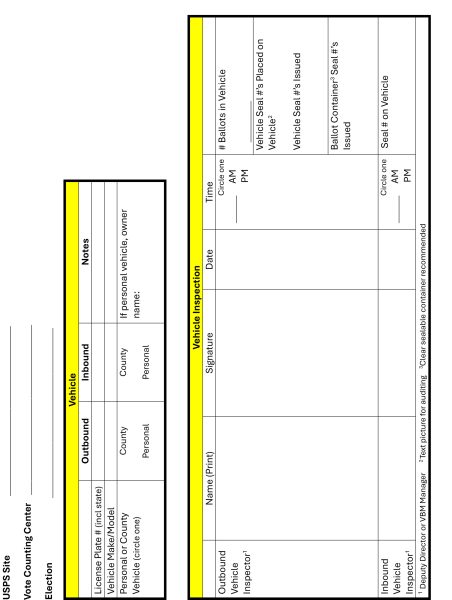
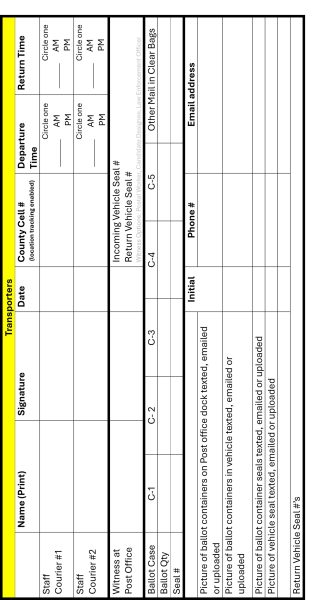
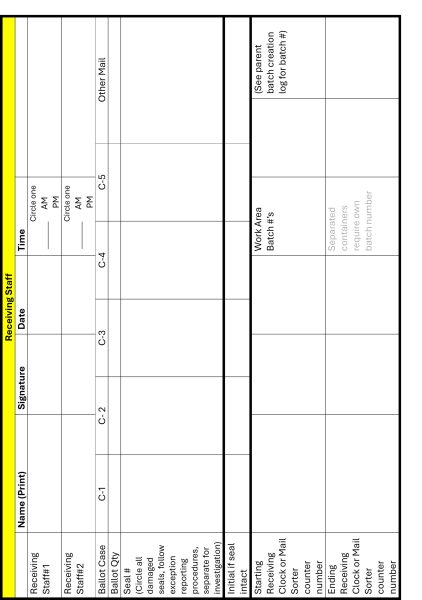
Exhibit 3 UOCAVA Facsimile Log
A facsimile machine should be dedicated to receiving UOCAVA ballots. Each brand of facsimile machine generates a report similar to the following report available on OKI facsimile machines.

Exhibit 4: Work Area Chain of Custody Logs
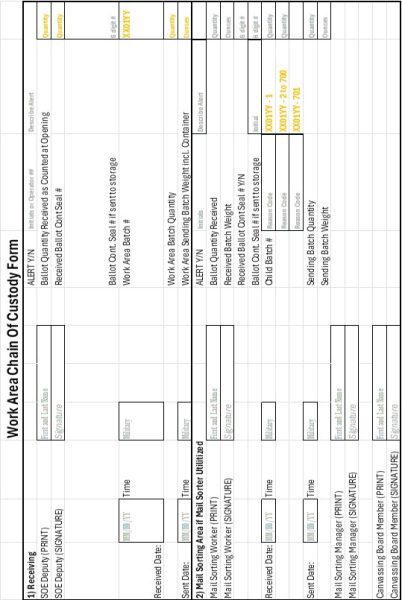
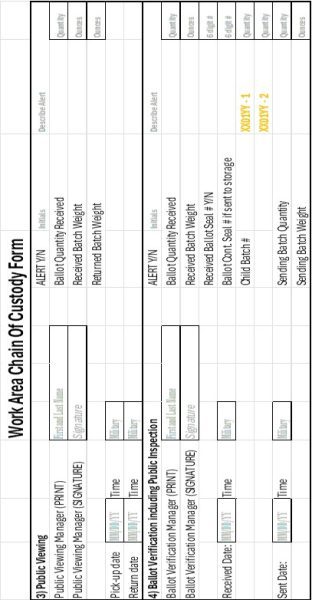
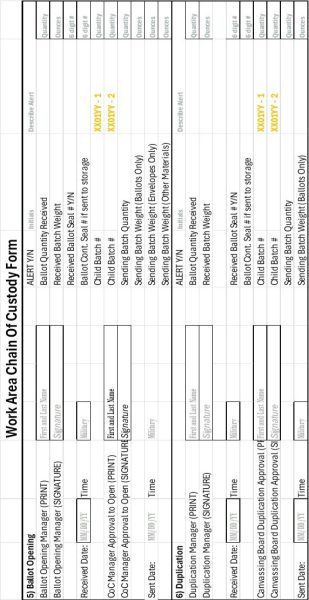
Exhibit 5: Vote-by-Mail Reconciliation – XXX Election Examples
| Vote By Mail Ballots | Quantity Processed Per Voter Registration System | Documentation Provided to Auditors and Public |
| Requested By Voters | 15,000 | Absentee Totals Report & Post Office Billing Records |
| Mailed To Voters | 14,500 | |
| Returned By Voters | 10,200 | |
| Signature & Eligibility Verified | 10,000 | |
| Tabulated | 10,000 |
| Chain of Custody Records | Quantity Received Per CoC Forms | Documentation Provided to Auditors and Public |
| Received From SBIS (Dropbox) | 2,000 | Completed SBIS Chain of Custody Forms |
| Received From Post Office | 7500 | Completed Post Office Chain of Custody Forms
Post Office Billing Records, Clocking-In, BallotTrax Records |
| Received Via UOCAVA Fax | 450 | UOCAVA Facsimile Log |
| Received at Election Offices or Election Center | 250 | Completed Election Office Chain of Custody Forms |
| Total | 10,200 |
Exhibit 6: Early Voting Reconciliation – XXX Election
Voting Site _____________ Date: ____________
Tabulator, E-Pollbook, & Voting Pass Reconciliation
- Opening tabulator Protected Count* _____________
- Opening tabulator Public Count* _____________
- Closing tabulator Protected Count _____________
- Closing tabulator Public Count ____________
- Tabulated Ballots TODAY based on Protected Count Increment ____________
- Tabulated Ballots TODAY based on Public Count Increment ____________
- Does #5 and #6 match, circle Y or N ____ Y / N___
- Total number of SIGNED Voting Passes issued TODAY _____________
- Abandoned Ballots TODAY, if any _____________
- Number of Issued and Completed Ballots Expected to Be ____ Y / N____
Tabulated = Number of signed Voting Passes – Abandoned Ballots
- Difference Between #8 and #10* _____________
- Number of voted ballots sealed for transport to Election Center _____________
- Number of ballots sealed for transport = #5 ____ Y / N____
*An Exception Report email shall be emailed if: 1) If opening tabulator Protected Count is higher than yesterday’s Closing Protected Count, 2) If opening tabulator Public Count is higher than yesterday’s Closing Public Count 3) If #13 is > 0. 4) If #7, 10 or 13 = N. Circle associated data entries.
Exhibit 7: Election Day Reconciliation
Voting Site _____________ Date: ____________
Tabulator, E-Pollbook, & Voting Pass Reconciliation
- Opening tabulator Protected Count* _____________
- Opening tabulator Public Count* _____________
- Closing tabulator Protected Count _____________
- Closing tabulator Public Count ____________
- Tabulated Ballots TODAY based on Protected Count Increment ____________
- Tabulated Ballots TODAY based on Public Count Increment ____________
- Does #6 and #7 match, circle Y or N ____ Y / N____
- Total number of SIGNED Voting Passes issued TODAY _____________
- Abandoned Ballots TODAY, if any _____________
- Number of Issued and Completed Ballots Expected to Be ____ Y / N____
- Tabulated = Number of signed Voting Passes – Abandoned Ballots
- Difference Between # 7 and #10* _____________
- Number of voted ballots sealed for transport to Election Center _____________
- Number of ballots sealed for transport = #5 ____ Y / N____
*An Exception Report email shall be emailed if: 1) If opening tabulator Protected Count is higher than yesterday’s Closing Protected Count, 2) If opening tabulator Public Count is higher than yesterday’s Closing Public Count 3) If #13 is > 0. 4) If #7, 10 or 13 = N. Circle associated data entries.
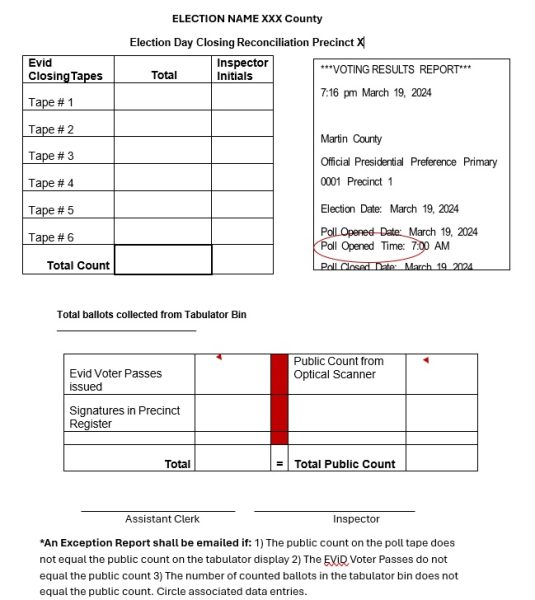
Exhibit 8 Public Observation, Recording, and Reporting
Vote-by-Mail
Observation:
- Initial facility inspection – Before the receiving of vote-by-mail ballots begins, candidates or their delegates may inspect the vote-counting center to verify no completed or blank vote-by-mail ballots are present and that physical security and public observation measures are adequate.
- The receiving docks may be observed 24×7 after the vote counting center inspection and through certification. The docks may be videotaped by the public if allowed by state law. If public videotaping from the building exterior is not allowed by law, the vote counting center will stream video of their receiving docks to enable public viewing.
- The completed and signed ballot chain of custody forms and the work area chain of custody forms generated from them shall be scanned in at the dock, signed by an authorized individual, observable, and auditable, stored, and emailed to the Chain of Custody manager. The original chain of custody forms will remain with the ballots within the ballot storage container. Ballot and work area chain of custody forms created at the dock shall also be displayed on a screen at the vote counting center and published on the Election Center website for the public to view.
- If there is a discrepancy on a chain of custody form, e.g. a broken seal, mismatched seal, difference in ballot quantities counted at the sending location and the dock location, or excessive travel times – dock personnel will create an Exception Report which will be stored and emailed to the Chain of Custody manager and posted for viewing on an in-building display and the Election Center website.
- If a clocking device is used, a picture is taken of the clock before each delivery begins to be clocked in and the end of clocking in of each delivery. A delivery may consist of a single ballot container or multiple ballot containers. The clocking device pictures showing the cumulative ballots clocked in before the delivery is clocked in and after the delivery clocking is complete, are stored and emailed to the Chain of Custody manager and displayed on a screen at the vote counting center and published on the Election Center website for the public to view.
- If a mail sorter is used, a report is generated after each delivery is processed noting the number of ballots processed in the delivery. The mail sort report is stored and emailed to the Chain of Custody manager and displayed on a screen at the vote counting center and published on the Election Center website for the public to view.
- As the ballots are moved between work areas of the vote counting center, the work area chain of custody forms are updated, scanned, stored, and emailed to the Chain of Custody manager. If there are any discrepancies in the work area chain of custody forms, an Exception Report is emailed to the Chain of Custody manager.
- If any ballots are separated from the ballot storage container, the work area chain of custody form must be updated after recounting the remaining ballots. A copy of the original chain of custody form will accompany the separated orphan ballot. A new work area chain of custody form with all fields completed will accompany the original chain of custody form and the separated ballots until destroyed.
- As the ballot counting is completed and ballots are sealed in containers for storage, the work area chain of custody form is updated or a new ticket generated which is scanned, stored, and emailed to the Chain of Custody manager.
- The final entry on the work area chain of custody form is made by the Storage manager who verifies the seal and places the ballots into secure storage which is under video surveillance with motion activated alerts and markers.
- After vote-by-mail ballot counting is completed, candidates or their delegates may tour the vote-counting center to verify no unprocessed ballots are present and that the processed ballots are sealed and securely stored.
Recording: Observers may make a written record and take a picture or video of:
- License plate of the delivery vehicle
- Ballot containers being unloaded from transport vehicles at the dock
- Empty delivery vehicle after ballots are removed
- Public monitors displaying Ballot Transport or Work Area chain of custody forms or video of operations
- Received ballot containers during public viewing
- Public monitors displaying ballot duplication activity if allowed by law
- Public monitors displaying mail sorter or tabulator reports
- Public monitors displaying Vote-by-Mail Reconciliation forms, Duplication Logs, and Adjudication Logs
- Any area or activity in processing of votes that does not expose a signature or a voted ballot.
Early Voting Locations
Observation: The public may observe:
- Drop boxes (SBIS) located inside or outside the polling location
- The receipt of voting and other election system equipment and supplies (candidate delegate only)
- The tabulator protected and public count display prior to and after the close of polls during early voting
- The e-pollbook counts prior to and after the close of polls during early voting
- The counting of signed voting passes
- The counting of voted and unvoted ballots
- Manual cross-checks done to verify vote and ballot quantities
Recording: Observers may make a written record or take a picture of:
- Daily opening and closing Public and Protected tabulator counts
- Daily opening and closing e-pollbook counts
- The number of signed voting passes issued
- The Daily Precinct and Early Voting Reconciliation Report
- Seals
- Any area or activity in processing of votes that does not expose a signature or a voted ballot
Election Day
Observation: Same as early voting plus the tabulator and e-pollbook tapes.
Recording: Same as early voting plus the tabulator and e-pollbook tapes.
Exhibit 9 Public Records Recommendations
Election records will be maintained and made available to auditors, candidates, and the public on a timely basis, prior to certification, at minimal or no cost. Redactions will be limited to those required by law with the statute that is the basis for the redaction in footnotes. Items below with an * are needed for reconciliation:
- Security plan
- Completed and blank ballot reconciliation forms for in-person voting and vote-by-mail*
- Completed chain of custody forms*
- UOCAVA facsimile logs*
- Post Office billing records*
- Daily ballot tracking service provider reports*
- Absentee Totals report (daily)*
- Audit Report or Log verifying signatures checked for vote-by-mail ballot mailing address change requests
- Undervote/Overvote report (daily)*
- Duplication Log that includes the reason
- Cast vote records
- Purchasing and receiving records of election materials, including ballots, envelopes, seals, mailing services, and temporary agencies*
- Completed and blank ballot accounting reports
- Voter registration data including vote history, method of registration, and audit logs
- Polling location tabulator tapes*
- Vote-by-mail tabulator tapes*
- e-pollbook tapes and logs*
- Ballot on Demand print logs
- Wireless carrier billing records for wireless modems used in tabulators, e-pollbooks, Ballot On Demand printers, or other election systems
- Mail sorter logs*
- Images of ballot envelopes collected by mail sorters with signature hidden
- HAVA violation reports
- Pictures or videos of poll tapes*
- Daily pictures of clock totals at the beginning and end of each workday
- Emails to Exception Reporting manager*
- Emails to Chain of Custody manager*
- Log of persons entering/exiting building when facility is closed
Here is the above information in a pdf file:
FATE2024 Election Official Reconciliation Guidebook v4 by Joe Ho on Scribd

 Conservative
Conservative  Search
Search Trending
Trending Current News
Current News 


